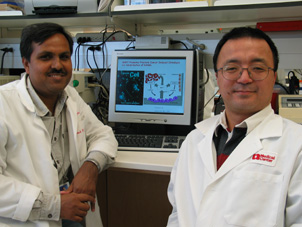 |
UNMC researchers Rakesh Singh, Ph.D., left, and Mitsuru Futakuchi, Ph.D. |
The findings provide critical insight into the process of prostate cancer-driven bone destruction and identify a treatment that may interrupt bone disease caused by the spread of prostate cancer. The research is published in the cover story in the May issue of Cancer Cell, a leading scientific journal.
The spread of cancer to other body regions is the primary cause of death from prostate cancer. The most common place for prostate cancer to metastasize is the bone, causing intense pain, pathological fracture, and immobility. At the current time, treatment options for patients with bone metastases are limited.
Rakesh Singh, Ph.D., associate professor of pathology and microbiology, and Mitsuru Futakuchi, Ph.D., a post doctoral research fellow, headed the collaborative study between UNMC, Vanderbilt University and Nagoya City University in Nagoya, Japan. Dr. Singh is the principal investigator. Dr. Futakuchi is a visiting postdoctoral fellow from Japan. Lynn Matrisian, Ph.D., chair of the department of cancer biology at Vanderbilt University, also was a key participant in the study.
The study, which has been ongoing for the past five years, used a new rodent model that mimics the changes to bone that occur following prostate cancer metastasis.
Transplantation of prostate tumor tissue onto bone surfaces provided a histological picture similar to human prostate cancers growing in the bone. The goal of the study was to look for mechanisms that drive the behavior of this disease, with the hope of discovering new therapeutic targets.
“Bone remodeling is always going on in the body. It’s a natural process,” said Dr. Singh. “What we found is that for the metastatic tumor to grow in the bone, it must exploit the normal bone remodeling process by using the same pathway.”
Dr. Futakuchi said: “Bone is not a very fun place for cancer to grow. For tumor cells to grow in the bone, a vicious cycle must occur involving bone destruction and the release of growth factors necessary for tumor cell growth. The destruction must occur, because the tumor needs the space to grow.”
The researchers identified genes that are expressed in the tumor-bone interface but not in the tumor alone. Several genes that play a role in bone physiology were abnormally regulated, including the gene for MMP-7.
MMP-7 is an enzyme that regulates communication between the tumor and surrounding normal tissue by processing cytokines and growth factors to active forms. MMP-7 has been shown to be involved in the invasion and spread of several cancers.
Cells called osteoclasts at the tumor-bone interface were observed to secrete MMP-7. Osteoclasts break down bone as part of normal bone remodeling, but are overactive in cancerous bone, leading to excessive bone destruction.
The researchers found that MMP-7 cleaved a molecule called RANKL into a soluble form that promoted osteoclast activation and bone degradation. Mice deficient in MMP-7 had little to no soluble RANKL and exhibited substantially reduced prostate cancer-induced bone degradation compared to control mice expressing MMP-7.
The researchers conclude that MMP-7 plays a major role in prostate cancer-driven osteolysis and that the mechanism of MMP-7 action involves cleavage of RANKL to a soluble form that promotes osteoclast activation and pathological bone breakdown.
“Our results make MMP-7 an attractive therapeutic target for the control of prostate cancer-induced bone osteolysis,” Dr. Futakuchi said.
Dr. Singh said the next step will be for researchers to extend the study to breast cancer. He said prostate and breast cancer are most likely to spread to the bones. In approximately 60 percent of patients with metastatic prostate or breast cancer, the metastasis occurs in the bone.
“This is all about quality of life,” Dr. Singh said. “Bone cancer is very painful and treatment options are lacking. We now need to look at these regulators of bone metastasis and try to develop targeted therapeutics that will prevent the bone metastasis from occurring.”